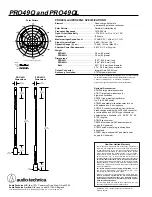
PRO
49
Q and PRO
49
QL
REMOTE-POWERED
CARDIOID CONDENSER
QUICK-MOUNT GOOSENECK
MICROPHONES
Frequency in Hertz
Response in dB
10 dB
20k
10k
5k
2k
1k
500
200
100
50
LEGEND
12" or more on axis
Frequency Response
Audio-Technica design engineers have utilized
the newest low-mass technology in the quest
for superior performance. The charge is now on
the fixed back plate, rather than the moving
element. With the A-T fixed-charge “back plate”
construction, a gold-vaporized diaphragm just
2 microns thick (about 0.000079") can be
used. This reduces moving mass substantially,
improving frequency response and transient
response while reducing distortion.
The microphone element is enclosed in a
rugged housing with a low-reflectance black
finish.
Operation and Maintenance
Output is low impedance balanced. The output
connector mates with XLRF-type connectors.
The balanced signal appears across Pins 2
and 3, while the ground (shield) connection
is Pin 1. Output is phased so that positive
acoustic pressure produces positive voltage
at Pin 2 in accordance with industry conven-
tion.
DC phantom power (9-52 volts) must be
applied equally to Pins 2 and 3, with the ground
for the power supply connected to Pin 1. This
can be provided by a console or mixer with
built-in phantom voltage or with the addition
of an in-line phantom power supply, such as
the recommended Audio-Technica CP8506
and AT8801 power supplies.
For balanced low-impedance inputs (required
for phantom power), AT8314 cable (or equal)
should be used. Regardless of cables used, it
is important that both ends of each cable are
wired consistently, with the shield always con-
nected to Pin 1 at both ends, Pin 2 connected
to Pin 2, and Pin 3 to Pin 3. This will ensure
that all microphones are electrically in phase
and reduce problems of uneven response
and sound cancellation when two microphones
are used close to each other.
The high sensitivity of the PRO 49Q ensures
useful output and an excellent match to most
mixer, tape recorder and amplifier inputs.
It will provide undistor ted output even in
sound fields as loud as 134 dB SPL. However,
due to the high sensitivity, in some instances
it may be possible to overload sensitive input
stages. If distortion occurs,
first check for
input overload. In such cases, an attenuator
such as the Audio-Technica AT8202 may be
required between the mic and the electronics
input. (Also, many mixers provide “input pad”
switches to reduce mic-input signal levels.)
The provided AT8146 windscreen simply slips
over the head of the microphone, effectively
reducing wind noise or “popping” when used
extra close.
The small-diameter gooseneck is very easy
to manipulate for proper positioning. It is
heavily lubricated to offer very smooth and
quiet operation. Should it become noisy with
prolonged use, apply a light machine oil
directly on the gooseneck area affected.
While a modern condenser microphone is
not unduly sensitive to the environment, tem-
perature extremes can be harmful. Exposure
to high temperatures can result in gradual
and permanent reduction of the output level.
Avoid leaving the microphone in the open sun
or in areas where temperatures exceed 110° F
(43° C) for long periods of time. Extremely
high humidity should also be avoided.
Description
The PRO 49Q is a wide-range condenser
microphone with a cardioid (unidirectional)
polar pattern. It was designed for high-quality
sound reinforcement and other demanding
sound pickup situations. With an overall length
of 13.07", its small-diameter alternating goose-
neck design permits highly flexible positioning
while maintaining a smooth, well-contoured
appearance. The PRO 49QL is a 16.46" version
of this microphone.
The PRO 49Q features an XLRM-type con-
nector insert at its base, allowing it to be
plugged directly into an XLRF-type jack or
cable connector. The unit’s integral electronics
can be powered from any external 9V to 52V
DC phantom power source.




















